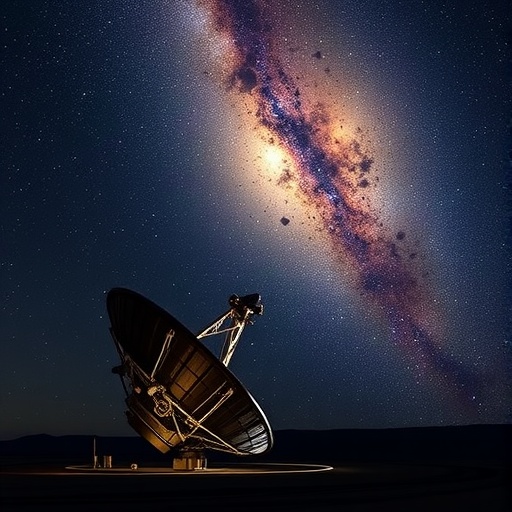A groundbreaking study led by researchers from Tel Aviv University has opened a new frontier in our quest to understand the elusive nature of dark matter through the detection of radio waves emitted during the Universe’s cosmic dark ages. This pioneering research offers an unprecedented window into a period roughly 100 million years after the Big Bang, a time predating the formation of the first stars, where dark matter played a pivotal role in shaping the cosmos.
The cosmic dark ages represent an enigmatic epoch in the cosmos when the Universe was filled predominantly with neutral hydrogen gas, unilluminated by stars. During this interval, dark matter—an invisible substance constituting the majority of the matter in the Universe—aggregated into dense clumps under gravitational attraction. These clumps exerted a potent influence on surrounding hydrogen atoms, causing them to emit faint but distinctive radio waves. According to the simulation-driven findings from Prof. Rennan Barkana and his colleagues, these emissions hold critical clues to decoding the properties of dark matter, which has long remained beyond the reach of direct observation.
The study utilized sophisticated computer simulations to model how dark matter’s gravitational wells pulled in primordial hydrogen gas, intensifying its radio signal due to energy exchanges within these clumps. This interaction effectively amplified the hydrogen’s 21-centimeter line emission—a hyperfine transition revealing the physical state of the gas. Detecting this signal from Earth is extraordinarily challenging due to interference from our atmosphere and human-made radio noise, rendering the cosmic dark ages nearly inaccessible with terrestrial instruments.
However, space-based observatories, particularly those positioned on the Moon’s far side, provide a pristine environment free from Earthly radio interference, crucial for capturing these ancient signals. The lunar environment’s stable conditions afford an ideal platform for radio telescopes to scan the sky for the weak emissions originating from the early Universe’s hydrogen gas. Despite the technical and logistical hurdles inherent in constructing and deploying lunar radio observatories, ongoing international efforts to explore lunar science pave the way for realizing this vision.
Prof. Barkana highlights the distinction between the cosmic dark ages and the subsequent cosmic dawn, when the first stars ignited and further complicated the cosmic radio landscape with their intense ultraviolet light. While the cosmic dawn’s radio signature is stronger and can be observed with large ground-based arrays like the upcoming Square Kilometre Array (SKA), interpreting these signals demands disentangling the complex astrophysical processes associated with star formation and ionization. Conversely, the cosmic dark ages present a cleaner, albeit subtler, laboratory to isolate dark matter’s footprint.
The research underscores the potential for current and planned radio telescope projects to measure the spatial fluctuations in the 21-centimeter background radiation. These fluctuations would manifest as a cosmic radio map delineating the distribution of dark matter clumps across vast cosmic expanses. This innovative method promises to bypass some of the conventional limitations of dark matter detection, which traditionally relies on gravitational lensing or particle physics experiments with limited sensitivity to certain dark matter properties.
Moreover, the study reveals that by quantifying the size and intensity of the detected hydrogen radio emission “nuggets,” scientists can infer the fundamental characteristics of dark matter particles, such as their interaction cross-section and mass. These parameters critically influence how dark matter clustered in the early Universe and subsequently guided the formation of galaxies and large-scale structure.
This novel approach to studying dark matter could revolutionize our understanding by leveraging signals that have traveled billions of years to reach us—essentially acting as cosmic beacons from an epoch hitherto concealed from observation. Additionally, this methodology aligns synergistically with ongoing efforts in astrophysics, combining observational campaigns with theoretical models to create a more cohesive and comprehensive picture of cosmic history.
The study, published in Nature Astronomy, represents collaboration among international scientists from Japan, India, the UK, and Israel, showcasing the global effort to unravel one of modern physics’ greatest mysteries. It also contextualizes how advancing astronomy technology—from terrestrial arrays to lunar-based detectors—fuels progress in fundamental science.
Interestingly, the research emphasizes that the early Universe’s pristine conditions offer a unique advantage for dark matter investigation. Unlike the current epoch, where dark matter interacts gravitationally amidst myriad celestial bodies and cosmic phenomena, the cosmic dark ages provide an unpolluted laboratory, enhancing the clarity with which dark matter’s intrinsic nature can be studied.
Prof. Barkana eloquently articulates the significance of opening “new observational windows” in astronomy: each new spectral or wavelength domain explored historically has revealed unexpected phenomena. With radio astronomy expanding beyond Earth, astronomers stand poised to “tune in” to the cosmic radio channels of the early Universe, potentially unlocking secrets that could reshape physics and cosmology.
This breakthrough research not only enriches our understanding of dark matter but also inspires a vision for future lunar missions and radio astronomy projects. As space agencies worldwide plan endeavors to inhabit and study the Moon, the scientific payoff of installing radio antennas there—a cosmic observatory beyond Earth’s electromagnetic noise—gains increasing momentum.
In summary, detecting the subtle radio echoes from the Universe’s infancy offers a compelling pathway to finally demystify dark matter, shedding light on its properties, origins, and role in cosmic evolution. By harnessing advanced simulations and envisaging lunar-based observations, Tel Aviv University’s team has charted a transformative course for next-generation astrophysical discovery.
Subject of Research: Dark Matter Detection through Radio Waves from the Early Universe’s Cosmic Dark Ages
Article Title: Not provided
News Publication Date: Not provided
Web References: http://dx.doi.org/10.1038/s41550-025-02637-0
References: Barkana, R., Sikder, S., et al. (2025). [Details as per Nature Astronomy publication]
Image Credits: Tel Aviv University
Keywords: Physical sciences, Astrophysics, Astroparticle physics, Observational astrophysics, Theoretical astrophysics, Cosmic dark ages, Radio astronomy, Dark matter, Hydrogen 21-centimeter line, Lunar radio telescope




